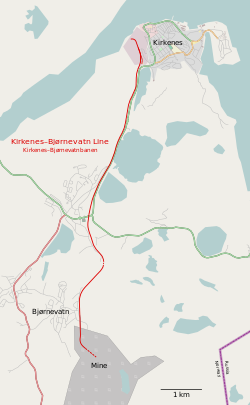Kirkenes–Bjørnevatn Line
| Kirkenes–Bjørnevatn Line | |||
|---|---|---|---|

The port at Kirkenes with the separator plant in the background
|
|||
| Overview | |||
| Type | Railway | ||
| Termini |
Kirkenes Station Bjørnevatn Station |
||
| Operation | |||
| Opened | 13 July 1910 | ||
| Owner | Northern Iron | ||
| Operator(s) | Northern Iron | ||
| Character | Iron ore | ||
| Rolling stock | Vossloh G 1000 BB | ||
| Technical | |||
| Line length | 8.5 km (5.3 mi) | ||
| Number of tracks | Single | ||
| Track gauge | 1,435 mm (4 ft 8 1⁄2 in) standard gauge | ||
| Electrification | 1912–55 | ||
| Operating speed | 45 km/h (28 mph) | ||
| Highest elevation | 77.0 m (252.6 ft) AMSL | ||
|
|||
The Kirkenes–Bjørnevatn Line (Norwegian: Kirkenes–Bjørnevatnbanen), or the Sydvaranger Line (Sydvarangerbanen), is a 8.5-kilometer (5.3 mi) long railway line between Kirkenes and Bjørnevatn in Sør-Varanger, Norway. Owned by the private mining company Northern Iron, the single-track railway is solely used to haul 20 daily iron ore trains from Bjørnevatn Mine to the port at Kirkenes. It was the world's northern-most railway until 2010, when the Obskaya–Bovanenkovo Line in Russia went further north.
The line was built by the mining company Sydvaranger, who started construction in 1907 and inaugurated the railway in 1910. From 1912, the port network received electrification, as did the mainline in 1920. Originally, free passenger trains services were also offered. During the Second World War, the line was largely destroyed, but rebuilt afterwards and re-opened in 1952. Electric traction was abandoned in 1955 when two EMD G12 diesel locomotives were bought. The line closed in 1997, but was reopened in 2009, following a change in ownership of the mine. There are proposals to connect the line to either one or both of the Finnish and Russian railway networks.
The Kirkenes–Bjørnevatn Line is 8.484 kilometers (5.272 mi) long and runs from Bjørnevatn Mine to Kirkenes Port. While the line had passenger transport, it had two stations, Kirkenes Station and Bjørnevatn Station, which were located 7.5 kilometers (4.7 mi) from each other. A third station, Armeverplegungslager, was only used during the Second World War and immediately afterwards and was located 5.01 kilometers (3.11 mi) from Kirkenes Station. The railway is standard gauge, non-electrified and single track.
...
Wikipedia

